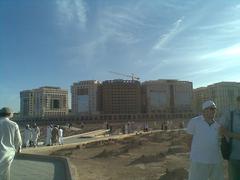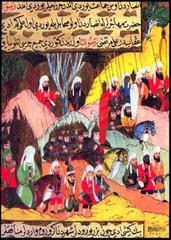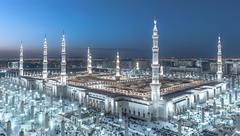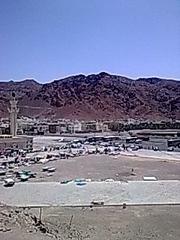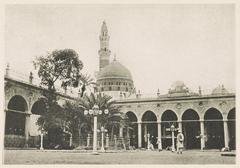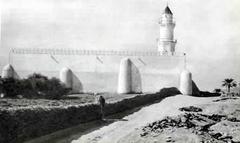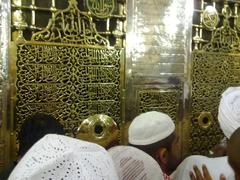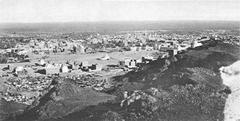
Al-Masjid an-Nabawi Visiting Hours, Tickets, and Historical Significance in Medina
Date: 04/07/2025
Introduction
Medina, known as Al Madinah Al Munawwarah—“The Radiant City”—is revered as the second holiest city in Islam after Mecca. At its heart lies Al-Masjid an-Nabawi (The Prophet’s Mosque), established by Prophet Muhammad (PBUH) in 622 CE. This sacred mosque attracts millions of Muslim pilgrims each year, serving as a focal point of Islamic faith, history, and architectural magnificence. Marked by its iconic Green Dome, which signifies the resting place of the Prophet and his closest companions, Al-Masjid an-Nabawi offers visitors a profound spiritual experience and invaluable cultural insights.
Medina itself is home to numerous other historic sites—including the Quba Mosque, Al-Qiblatain Mosque, Jannat al-Baqi Cemetery, and Mount Uhud—that collectively narrate the story of early Islam. These, alongside museums, vibrant markets, and natural attractions, enhance the city’s appeal as both a pilgrimage and cultural destination.
This detailed guide covers essential information for visiting Al-Masjid an-Nabawi and other significant Medina landmarks, including visiting hours, ticketing, accessibility, etiquette, travel tips, and recommended nearby attractions. Whether you are a pilgrim or a history enthusiast, this resource will help you plan your journey with respect and understanding. For real-time updates and itineraries, consider using the Audiala app or reputable travel resources (Saudi Arabia Tours; Nomadic Samuel).
Table of Contents
- Introduction
- Historical and Religious Significance of Al-Masjid an-Nabawi
- Visiting Information for Al-Masjid an-Nabawi
- Key Nearby Historical Sites
- Museums and Cultural Attractions
- Natural and Recreational Attractions
- Transportation and Access
- Visitor Tips and Etiquette
- Guided Tours and Special Events
- FAQ
- Conclusion
- References
Historical and Religious Significance
Al-Masjid an-Nabawi: Origins and Spiritual Importance
Al-Masjid an-Nabawi was established by Prophet Muhammad (PBUH) upon his migration to Medina. The mosque is the burial site of the Prophet and his two closest companions, Abu Bakr and Umar, all beneath the Green Dome. It is the world’s second-largest mosque and, during peak pilgrimage seasons, accommodates up to two million worshippers (Nomadic Samuel; Medina Hotels). The Rawdah, a section within the mosque, is described in hadith as a garden from the gardens of Paradise.
Architectural Features and Expansions
Originally a simple structure, the mosque has undergone numerous expansions under Umayyad, Abbasid, Ottoman, and Saudi rulers. Today it features vast prayer halls, towering minarets, ornate domes, and state-of-the-art facilities for ablution and accessibility. Exhibitions within the mosque display rare Islamic artifacts (Saudi Arabia Tours; Swiss International Taba Al Salam).
Visiting Information
Visiting Hours and Entry Requirements
- Masjid an-Nabawi: Open 24/7 for Muslim worshippers. Non-Muslims are not permitted inside the mosque’s central precincts.
- Dress Code: Modest, loose-fitting clothing is required. Women must wear an abaya and headscarf, and men should wear long trousers and sleeved shirts (Traveloka).
- Entry Fee: There is no charge to enter Masjid an-Nabawi.
Accessibility and Facilities
The mosque has wheelchair-accessible entrances, ramps, and prayer halls for visitors with disabilities. Facilities also include clean ablution areas, multilingual signage, and designated prayer spaces for women.
Photography and Behavior Guidelines
Photography is restricted inside Masjid an-Nabawi, especially near the Prophet’s tomb and the Rawdah. Always seek permission before photographing others and respect signage (Swiss International Taba Al Salam).
Key Nearby Historical Sites
Quba Mosque
- Significance: The first mosque built in Islam, founded by the Prophet upon his arrival in Medina (Travel Culture).
- Visiting Hours: Open daily, typically from Fajr (dawn) to Isha (night) prayer; no entry fee.
- Accessibility: Ramps and modern facilities available (Saudipedia).
- Dress Code: Modest attire required for both men and women (thewanderingafro.com).
- Etiquette: Enter with the right foot, recite the du’a, maintain silence, and avoid photography during prayer times (soulofsaudi.com; puretrip24.com).
- Access for Non-Muslims: Entry restricted to Muslims (thewanderingafro.com). Surrounding markets and cafes are open to all.
- Nearby Attractions: Quba Front marketplace, local cafes, guided tours available (blog.wasalt.sa).
Al-Qiblatain Mosque
- Significance: Site where the qibla (direction of prayer) changed from Jerusalem to Mecca (Nomadic Samuel).
- Visiting Hours: Open daily; no ticket required.
Jannat al-Baqi Cemetery
- Significance: Final resting place for many family members and companions of the Prophet.
- Access: Restricted to Muslims (VisitAlMadinah).
Mount Uhud
- Significance: Site of the Battle of Uhud, offering a place for reflection and remembrance.
- Open: Daily, sunrise to sunset; free access (MakeMyTrip).
Seven Mosques (Saba Masajid)
- Significance: Group of historic mosques near the site of the Battle of the Trench.
- Visiting Hours: 7:00 AM to 6:00 PM.
Museums and Cultural Attractions
AlMadina Museum
- Exhibits: Chronicles Medina’s history from pre-Islamic to modern times.
- Hours: 9:00 AM to 5:00 PM (closed Fridays).
- Tickets: Approx. SAR 20 (TravelSetu).
Dar Al Madinah Museum
- Focus: Medina’s architectural and urban evolution.
- Hours: 9:00 AM to 6:00 PM; Tickets: SAR 15 (TravelSetu).
Natural and Recreational Attractions
- King Fahd Central Park: Green space with walking trails and play areas, open 6:00 AM to 10:00 PM (MakeMyTrip).
- Wadi E Jinn & Wadi Aqiq: Notable for unique natural phenomena and scenic beauty.
Transportation and Access
- By Air: Prince Mohammad bin Abdulaziz International Airport (MED), 15 km from city center. Taxis, shuttles, and car rentals available (TravelSetu).
- By Train: Haramain High-Speed Railway connects Medina with Mecca, Jeddah, and King Abdullah Economic City (TravelSetu).
- By Road: Luxury buses and ride-hailing apps (Uber, Careem) widely used in Medina (TravelSetu).
Visitor Tips and Etiquette
- Dress Code: Abayas and headscarves for women; long pants and sleeves for men (Travel Around The World Blog).
- Behavior: Quiet, respectful demeanor near holy sites; remove shoes before entering mosques.
- Prayer Times: Shops and restaurants close for prayers; visitors should avoid disruptions (Travel Around The World Blog).
- Best Time to Visit: October to March for milder weather.
- Access for Non-Muslims: Non-Muslims can visit museums, parks, and markets, but mosque precincts are restricted (MakeMyTrip).
- Health and Safety: Stay hydrated and observe local health guidelines (Agoda).
- Special Events: Ramadan, Medina Date Festival, and religious holidays offer unique cultural experiences (Agoda).
Frequently Asked Questions (FAQ)
Q: Are tickets required for Al-Masjid an-Nabawi or Quba Mosque?
A: No, entry is free for both, but restricted to Muslims.
Q: Can non-Muslims visit Medina?
A: Non-Muslims may visit many parts of Medina but are restricted from the central mosque area.
Q: Are guided tours available?
A: Yes, numerous agencies offer guided tours covering Medina’s history and landmarks.
Q: Is Medina accessible for those with disabilities?
A: Major sites like Al-Masjid an-Nabawi have ramps and accessible facilities.
Q: What is the best time to visit?
A: Cooler months from October to March are ideal.
Summary and Final Tips
Al-Masjid an-Nabawi is the spiritual heart of Medina and a pivotal site for Islamic history and pilgrimage. Its round-the-clock accessibility for Muslim worshippers, proximity to other revered sites, and the city’s blend of tradition and modern convenience make Medina a prime destination for both spiritual and cultural journeys.
Visitors should respect local customs, adhere to modest dress codes, and be mindful of prayer times. Leveraging guided tours and travel apps like Audiala can enhance the experience and provide up-to-date information. Medina’s renowned hospitality, preserved heritage, and vibrant markets offer enriching opportunities beyond religious observance.
As you plan your visit, use trusted resources for updates and guidance, and approach Medina’s sacred spaces with respect and reverence (VisitAlMadinah; TravelSetu).
References
- Saudi Arabia Tours: Visiting Al-Masjid an-Nabawi
- Nomadic Samuel: Medina City Guide
- Travel Culture: Quba Mosque Historical Significance
- MakeMyTrip: Places to Visit in Medina
- Audiala: Quba Mosque Visitor Etiquette
- VisitAlMadinah: Medina Travel Guide
- Soul of Saudi: Mosque Etiquette Guidelines
- TravelSetu: Medina Tourism Guide
- Saudipedia: Quba Mosque
- thewanderingafro.com: Visiting Masjid Al-Quba
- puretrip24.com: Masjid Quba Complete Guide
- blog.wasalt.sa: Masjid Quba
- Swiss International Taba Al Salam: Guide to Masjid an-Nabawi
- Traveloka: Dos and Don’ts Saudi Arabia
- Travel Around The World Blog: Medina Travel Etiquette
- Agoda: Top 10 Things to Do in Medina
Explore Medina’s spiritual and historical treasures with respect and curiosity. Download the Audiala app for up-to-date guides, tour options, and essential visitor information.

